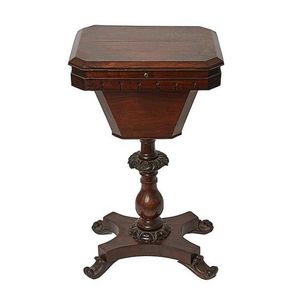Empire Style Mahogany Wine Coolers with Rams Head Supports
A pair of Empire style mahogany wine coolers, each rectangular in form inset with galvanised metal basins. Each raised on double 'X' shaped rams head supports joining to a shaped platform base, each approximately 77 cm high, 47.5 cm wide and 71 cm long
You must be a subscriber, and be logged in to view price and dealer details.
Subscribe Now to view actual auction price for this item
When you subscribe, you have the option of setting the currency in which to display prices to $Au, $US, $NZ or Stg.
This item has been sold, and the description, image and price are for reference purposes only.
- Mahogany - Mahogany is a dense, close grained red-coloured timber from the West Indies and Central America. It was first imported into Europe in the the early 18th century and its use continued through the 19th century. It was popular for furniture making because of its strength, the wide boards available, the distinctive grain on some boards, termed flame mahogany and the rich warm colour of the timber when it was polished.. The "flame" was produced where a limb grew out from the trunk of the tree, and this timber was usually sliced into veneers for feature panels on doors, backs and cornices.
Some terms used to describe mahogany relate to the country from which it originally came, such as "Cuban" mahogany, "Honduras" mahogany etc. However unless the wood has been tested the names assigned are more a selling feature, rather than a true indication of the timber's origin. - Empire Style - The Empire style was a version of neo-classicism popular from 1800 to 1830, coinciding with the rule of Napoleon I from 1840-15. In England the style corrosponds with the Regency style and in the United States to the Federal style.
The style is inspired by classical Rome and Greece, as reflected in the decorative motifs in the the design such as paterae, guilloches, acanthus and swags, and pieces are lavishly decorated with applied gilded decoration. - Platform Base - Flat-surfaced bases supporting the pedestals of dining tables and some other smaller occasional tables, including console and pier tables. Introduced during the Regency period, they continued in popularity throughout the 19th century. On tables, platform bases are usually of triform, or three-cornered shape, supported by bun, turned or carved claw feet. They may be either of veneered box-like construction, or formed from the solid timber.
This item has been included into following indexes:
Visually similar items

Beidermeier work table, with a lyre base, Sweden, c. 1845
Sold by
in
for
You can display prices in $Au, $US, $NZ or Stg.

A Victorian mahogany sewing table, with carved pedestal and platform base with four scroll feet.
Sold by
in
for
You can display prices in $Au, $US, $NZ or Stg.

Antique French rustic table, approx 102 cm wide, 64 cm high, 74 cm deep
Sold by
in
for
You can display prices in $Au, $US, $NZ or Stg.

An Australian Art Deco occasional table, huon and blackwood top, fiddleback, maple, silky oak and eucalypt, circa 1920, 54 cm high, 74 cm wide, 48 cm deep
Sold by
in
for
You can display prices in $Au, $US, $NZ or Stg.
